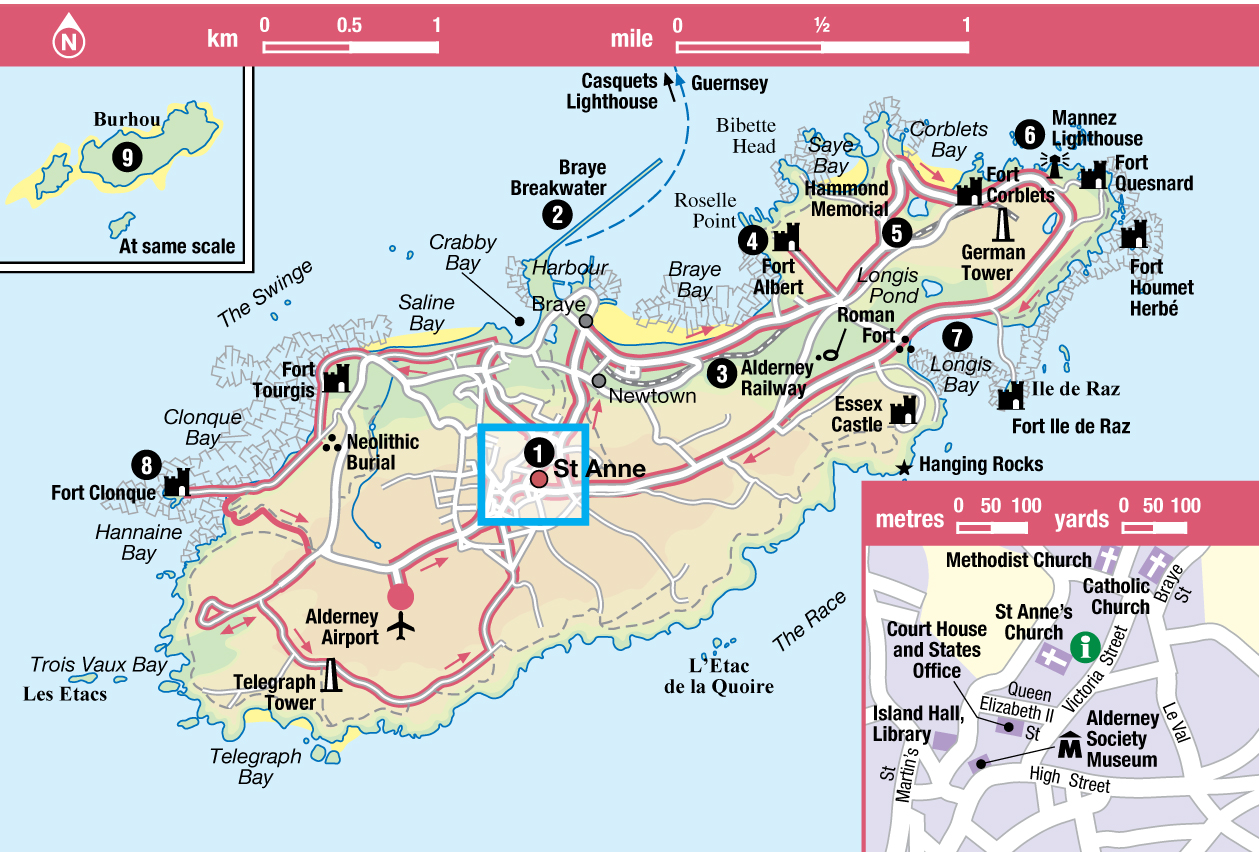
Tour 8 : Alderney
Unwind on this peaceful little island caught in a time warp. The 13-mile (21km) tour, either by bike or car and foot, takes a whole day
Highlights
Alderney lies just 8 miles (13km) west of Normandy, and the cobbled streets of its only town, St Anne, have a distinctly Gallic atmosphere. Some 3½ miles (5.5km) long and 1½ miles (2.5km) wide, it has cliffs to the south but to the north it slopes gently down to a series of beautiful sandy bays.

A shopping street in St Anne.
The island has largely escaped mainstream tourism and remains quiet and unspoilt, with a friendly and relaxed atmosphere and a refreshing lack of bureaucracy. It certainly feels very different from Jersey or Guernsey – it is much more sparsely populated and quite remote. There are more than 50 miles (80km) of footpaths and walks around the island, and it’s a haven for bird-lovers and ornithologists.
Islanders from Guernsey and Jersey come for beaches, golf, quirky shops and – last but not least – the restaurants and watering holes. The islanders have a reputation for conviviality and there is a definite emphasis on taking time out to eat, drink and be merry. If you’re tired of walking Alderney’s wind-blasted cliffs in a squall, sitting in a warm pub is the best thing to do. The pubs are more like clubs – full of character and characters, and the natural place to be on an island that offers few places of entertainment. Alderney stole a march on Guernsey by being the first to allow publicans to open on Sundays.
Alderney’s character differs somewhat from the other islands, partly because it was deliberately depopulated during World War II and used as a forced labour camp. The island was massively fortified by the Germans; relics of the Occupation can be seen along the coastline.
Alderney is small enough to feel like an island, with the sea nearly always in view, yet large enough for day-trippers to leave feeling that they could have done with a little more time. If you decide to stay overnight there are several hotels and guesthouses.
This day tour of the island can be covered either entirely by bike, or by a combination of car and foot. If time is limited there are regular bus tours of the island, available on certain days, or taxis that offer affordable tours.
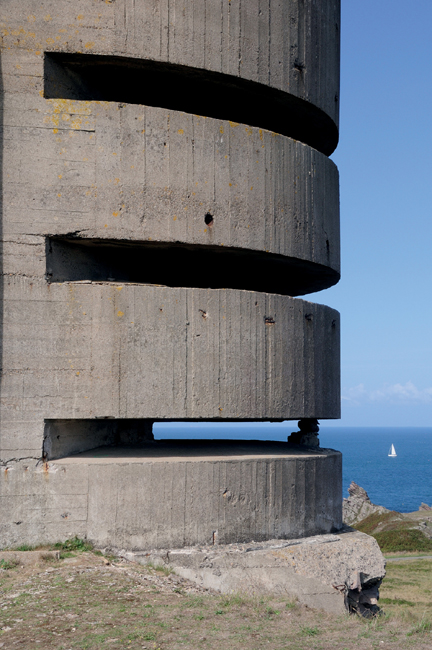
A German watchtower.
Mockford and Bonetti/Apa Publications
Getting to Alderney
From Guernsey the easiest way to get to Alderney is to hop across by plane. If you’re accustomed to bargain-basement flights this is a journey of a lifetime. You’ll travel in one of the tiny Trislanders, the pilot welcomes you in person and everyone has a window seat with wonderful views. Look closely and you can almost see the lobster pots. Alderney Airport was the first officially recognised airport of the Channel Islands, opened in 1935, and still not much more than a few prefab huts and a hangar. Going by sea (www.bumblebee.gg) is a cheaper option, but the boat takes an hour as opposed to a 15-minute flight.
Capital Shopping
The shops in St Anne are delightfully quirky. No high street stores or Starbucks here, but family butchers and bakers, shops selling fishing tackle, bric-a-brac and sweets in old-fashioned large glass jars. As in France, all the shops close down for a two hour lunch break. If you’re feeling the breeze, walk down to Channel Jumpers in Braye Street where you can buy traditional Guernsey and Alderney sweaters.
For the energetic visitor, hiring a bike is a good way of seeing the island (Cycle & Surf, St Anne, tel: 01481-822 286 or Auto Motion, Braye Harbour, tel: 01481-823 352). You can’t cover the entire island in a day on foot, but there are some wonderful walks and distances between the main landmarks are easily walkable. Taxis will be waiting at the airport for round-the-island tours (ABC Taxis, tel: 01381-823 760, Island Taxis, tel: 01481-823 823). ABC Taxis operate very reasonably priced two-hour tours of the island departing at 2pm from the bottom of Victoria Street, St Anne, on Tuesday, Wednesday and Thursday. You can also hire a car (Braye Hire Cars, tel: 01481-823 881; www.brayehirecars.com). Driving couldn’t be easier: no traffic lights, no road rage and not much traffic.

A plaque in Victoria Street commemorates the monarch’s visit.
Visit Guernsey
ST ANNE
The capital, St Anne 1 [map] (referred to by locals simply as ‘town’) is an attractive maze of cobbled streets lined by houses of granite and sandstone, many of them whitewashed or painted in lovely pastel shades. Victoria Street, named after the monarch who visited Alderney on 9 August 1854, has most of Alderney’s shops and restaurants. It’s worth popping into the Alderney Visitor and Wildlife Information Centre for some excellent walking guides.
Just south of the information centre is the entrance to St Anne’s Church. This massive French-style building of local granite, with Caen stone details, was designed by Sir George Gilbert Scott in ‘chaste Gothic’ style, and opened in 1850. It replaced the old church, which was described at the time as ‘small and mean’. The body of the Old Church was demolished, but you will find the squat tower, which survived, and the old churchyard, containing some fine 18th-century tombstones, by continuing to the top of Victoria Street and then turning right into the High Street.
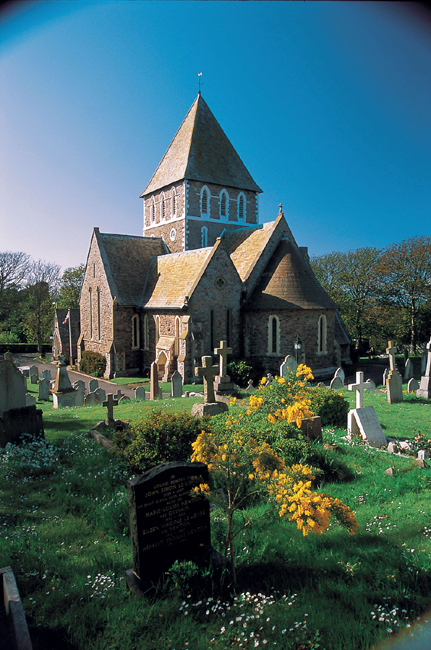
St Anne’s Church on Alderney is often referred to as the Cathedral of the Channel Islands.
Mockford and Bonetti/Apa Publications
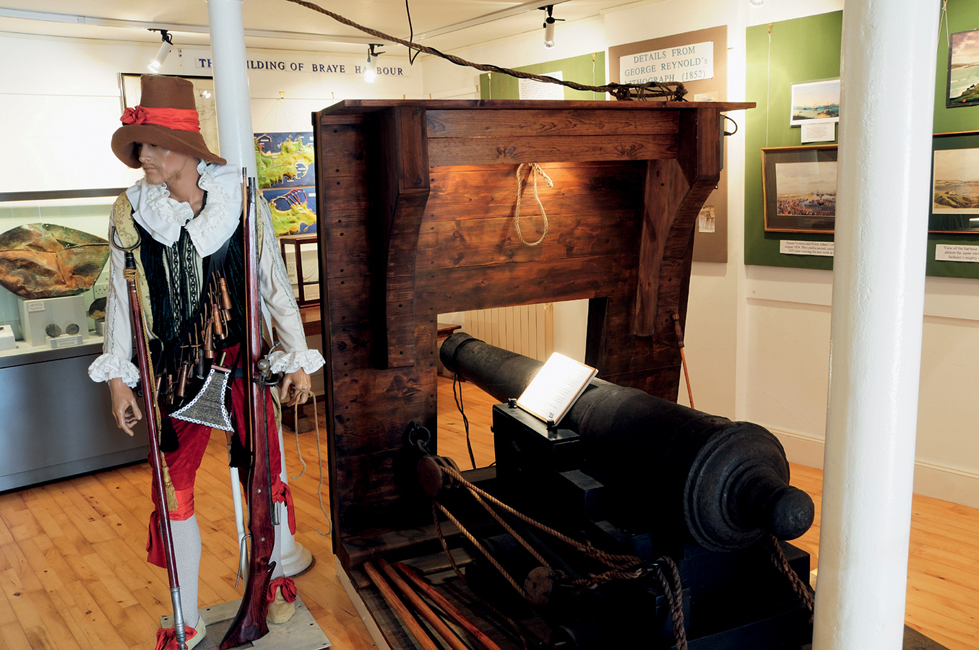
Cannon found in an Elizabethan wreck, Alderney Society Museum.
Mockford and Bonetti/Apa Publications
ALDERNEY SOCIETY MUSEUM
The tower and churchyard stand near the Alderney Society Museum (Easter–Oct Mon–Fri 10am–noon and 2.30–4.30pm, Sat–Sun 10am–noon; charge), which is housed in the former Old School, founded in 1790 by the island’s governor, Jean Le Mesurier. The museum provides a detailed account of the island, from its geology and wildlife to such topics as whether the Alderney cow ever existed as a distinct breed.
One section deals with wartime Occupation and the evacuation of all but a handful of the island’s population. From 1942–4 Alderney was used as a forced labour camp with almost 5,000 labourers from all over Europe transported here to turn the island into an impregnable fortress. The labourers toiled in harsh conditions; several hundred of them died from starvation and brutality. Alderney had the only concentration camp on British soil during the war, with 1,000 inmates from Sachsenhausen concentration camp transported here to work on fortifications.
When the Alderney residents were allowed to return in the winter of 1945, they had to agree to work cooperatively, under central management, to restore houses and farmland left derelict by the occupying forces. Hard work and self-sacrifice saw the island economy restored within two years, but there were moments of farce, as illustrated by the infamous Battle of the Butes. This took place in 1945 after British troops, preparing for the islanders’ return, cleaned out their homes and stacked such furniture as had survived in the open air, with a rope barrier. A free-for-all broke loose once the rope was removed, with islanders fighting each other for their possessions. For decades after, it is said, some people on the island refused to invite others into their homes for fear that their guest might recognise a family heirloom.
Another section of the museum displays artefacts salvaged from the Elizabethan warship, the 60ft (18-metre) Makeshift, wrecked off the coast of Alderney and discovered in 1977 by a fisherman. Apart from a cannon, pottery and leather clothing, two of the most intriguing finds are early tobacco pipes – one made of pottery and one of pewter – with tiny bowls, reflecting the fact that tobacco, introduced to Europe only two decades previously, was still a very expensive luxury.

Island Hall, where Alderney parliament used to hold its meetings.
Mockford and Bonetti/Apa Publications
ISLAND HALL
Close to the museum are some of Alderney’s oldest buildings: turning right just beyond the museum will take you into Connaught Square, with the Old Government House of 1763, now better known as Island Hall where States of Alderney, the island parliament, used to hold its meetings. It is now the seat of the States’ civil service department. The imposing Georgian building was originally constructed as a private house for the Le Mesuriers, the hereditary governors of Alderney, who clawed their way to wealth and status through acts of licensed piracy. In one year alone during the wars with France, Jean Le Mesurier, under a licence granted by the English Crown, captured shipping valued at £135,000 – a fortune in the late 18th century.
BRAYE
From the centre of St Anne it’s just a few minutes’ walk down the hill to Braye Harbour. The great sandy sweep of Braye beach is protected by the Alderney breakwater and therefore offers sheltered bathing. The harbour is safe from the strong current of the Swinge, just off-shore. For all its small size, Braye has more than its fair share of places to eat, from chip shops and pubs to up-market seafood restaurants.

Braye Harbour has one of the longest harbour walls in Europe.
Visit Guernsey
THE BRAYE BREAKWATER
Along with Alderney’s ring of 12 defensive fortifications, the Braye Breakwater 2 [map] is a legacy of the suspicion that existed between England and France in the early 19th century, even though hostilities officially ceased after the defeat of Napoleon. When the French began constructing a naval harbour at Cherbourg, alarm bells rang in the Admiralty, and the British government suddenly decided it was urgent to build ‘harbours of refuge’ at Braye on Alderney, as well as on Guernsey and Jersey. The intention was to convert Braye harbour into a massive naval base, with a breakwater at each side of the bay. Only the western wall was built, completed in 1847 and originally a mile (½km) long. Battered by massive waves (signs warn walkers that the wall is liable to sudden swamping by breaking waves), part of the breakwater was abandoned and now lies submerged beneath the waves, a hazard to shipping.
The Alderney Spike Girls
Only on Alderney are you ever likely to see a blonde hedgehog. These creamy-coloured flea-free creatures, with beady button-black eyes, have a rare recessive gene. There is a population of around 1,000 on the island and they have been breeding here since a couple of them were released in the 1960s – allegedly from a Harrods shopping bag. You are most likely to see them at dusk or in the early morning.
Cricketing Ties
Alderney has strong links with well-known cricketing characters. John Arlott, once His Master’s Voice of BBC cricket commentaries, retired to Alderney in 1981 saying it was a ‘desperately easy place’ to live in with a ‘pleasant absence of bores’. Ian Botham was a regular player here and had a holiday home on the island. Since the 19th century cricket has been played on Les Butes, a spectacular pitch with sea views.
Today local fishermen cast their lines from the breakwater, and during winter storms locals congregate here to watch the waves crash dramatically against the wall.
THE ALDERNEY RAILWAY
The Alderney Railway 3 [map] , one of the oldest in the British Isles, was constructed in the 1840s by the British government to convey stone from Mannez Quarry to build the breakwater and the forts. The first official passengers were Queen Victoria and Prince Albert, who were carried in 1854 in a horse-drawn tender.
At weekends and on bank holidays from Easter to September, the railway carries passengers on a 2-mile (3km) trip from the harbour up to the north-east coast, a journey of 15 minutes (departures at 2.30pm and 3.30pm on Sun in May–June, Sat and Sun in July, Sun in September; for information tel: 01481-822 978 or visit www.alderneyrailway.com). Passengers are either carried in a diesel-powered railcar, or in one of two 1938 London Underground carriages. The bright red tube carriages shuttling beneath the gorse- and bracken-covered hills of Longis Common make a bizarre sight.
THE NORTHEAST COAST

An abandoned rail line along the Braye harbour breakwater.
Visit Guernsey
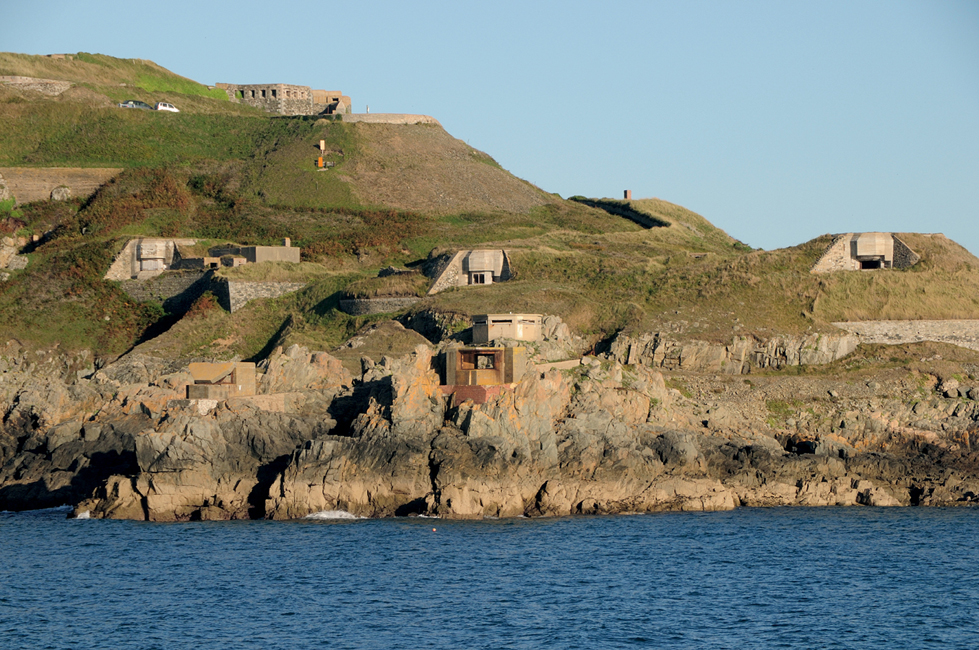
Fort Albert affords wonderful views of the marine life in Braye harbour.
Mockford and Bonetti/Apa Publications
A circular road hugs the northeastern coast, forming a loop from Braye back to St Anne. Following the Lower Road east out of Braye, you will skirt Braye Bay and encounter Fort Albert 4 [map] , the first in the chain of 12 fortresses encircling the island, designed in the 1840s and 1850s. Suspicious of French intentions, the English imported hundreds of English and Irish labourers to construct these fine fortifications of pink granite, but most were never subsequently garrisoned. Several have now been converted into private flats and holiday apartments, while others remain in a decayed and dangerous state – best appreciated from afar. Fort Albert is perhaps the finest of them all, and is well positioned to defend Braye Harbour.
HAMMOND MEMORIAL
A short way on, the road divides; the spot is marked by the Hammond Memorial 5 [map] commemorating the many prisoners of war who died on Alderney during the Occupation period. They were imported to work as slave labourers on the construction of the defences that were to turn the Channel Islands into the most heavily fortified area in Europe. Plaques in Hebrew, Polish, Russian and Spanish indicate the origins of those who lost their lives: Spanish partisans who were on the losing side in the Civil War, Jews from Alsace and Czechoslovakia, and prisoners of war from Russia and Poland.
SAYE AND CORBLETS BAYS
Fork left at the memorial for Saye Bay (pronounced ‘Soy’), an idyllic horseshoe-shaped white-sand beach between rocky headlands. Children love leaping off the rocks here – and in summer it’s popular with campers from the island’s only campsite just over the dunes. The next beach along is the delightful Corblets Bay, with clean sands and shallow waters. This is the best beach on the island for surfing and bodyboarding.
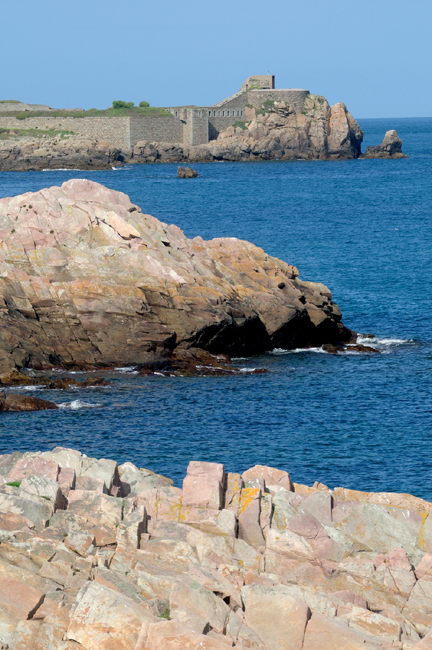
Corblets Bay offers excellent swimming and surfing.
Mockford and Bonetti/Apa Publications
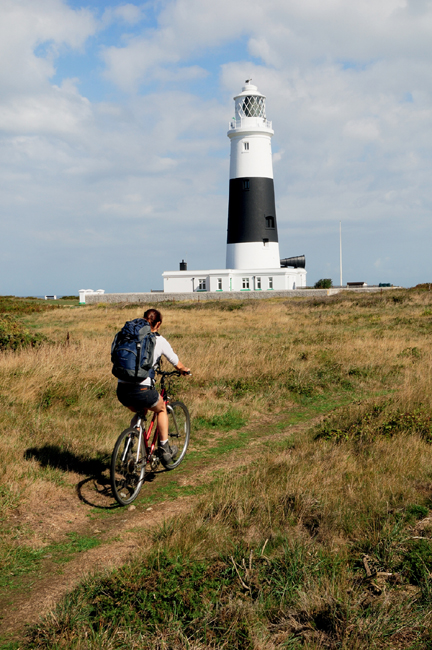
The Mannez Lighthouse beam is visible 23 miles (37km) out to sea.
Mockford and Bonetti/Apa Publications
Mannez Quarry and Lighthouse
Evidence of quarrying activity lies all around the northeastern tip of the island at Mannez Quarry, close to the railway station terminus. Above the quarry stands the large and sinister fire control tower, built by the Germans to act as a command post for the various artillery batteries around the island. It is known locally as The Odeon. From here there are clear views across to the Cap de la Hague in Normandy. Mannez Pond at the eastern end of the quarry provides a rich habitat for wetland birds as well as Alderney’s nine species of dragonflies. Mannez Lighthouse 6 [map] (closed indefinitely to visitors) is Alderney’s most conspicuous landmark. It was built in 1912 to aid vessels along this treacherous stretch of coast.
LONGIS BAY
Continuing round the coast, another fine stretch of sandy beach is found at Longis Bay 7 [map] . Additional shelter is provided by the massive concrete anti-tank wall. This was partially constructed by the Germans, who were convinced that the Allies would eventually try to retake the Channel Islands by landing tanks and troops. The structure remains incomplete. At the far end of Longis Bay, an attractive château-like building, known locally as The Nunnery, stands on the site of Alderney’s Roman fort. It was here that the coins, pottery and bronze work in Alderney Museum were excavated, while much of the museum’s Iron-Age material came from a site on the adjacent golf course. Just to the north, Longis Pond has a bird-hide, information point and bird feeding area, perfect for ornithologists.
HANGING ROCKS

Longis Bay features an uncompleted tank wall and sandy beaches.
Mockford and Bonetti/Apa Publications
Puffin Webcam
The Alderney Wildlife Trust’s puffin webcam (www.alderneywildlife.org) streams live footage of puffins on the island of Burhou. The best time to check out the puffins is during the afternoon and early evening. From June onwards you may see adults returning with fish and sand eels for their growing chicks. The site also features a puffin forum and information on the birds and their habitats.
The Nunnery marks the point at which Alderney’s lowlands give out. Just to the south, the cliffs rise steeply to the landmark known as the Hanging Rocks. Here, two huge boulders look as if they have detached themselves from the cliff and are about to tumble into the sea. One local legend has it that Jerseymen, jealous of Alderney’s beauty, once tried to tow the island closer to their own by attaching a rope to the rocks; all they succeeded in doing was to tilt the rocks. Essex Castle, now private flats, stands high above the rocks, while the main road leads straight uphill, back to St Anne.
SOUTH OF THE ISLAND
The southern part of the island can only properly be explored on foot or by bike, since the best parts of the coast are only accessible by paths. Allow a couple of hours for this 5-mile (8km) exploration of the southern cliffs and take binoculars for spectacular views of gannetries.
If you are coming from St Anne, start at the church and take the western exit from the churchyard. Turn right to follow the road called La Vallée down to the sea at Saline Bay. Turn left to follow the coast road, past Fort Tourgis, derelict for 30 years.
Take the road to the right of the fort to follow the coast. The surfaced road soon gives way to a track, leading to Fort Clonque 8 [map] , built in 1854 and sited on an offshore islet. The fort has been converted to holiday apartments by the Landmark Trust. You can only access the fort when the tide is out, as the causeway is covered by water at high tide. The intertidal rocks at Clonque Bay are perfect for rock pooling. At the northern end, the wreck of the SS Emily Eveson reveals itself at low tide. You can then walk out and look inside its boiler, but beware of the tides.
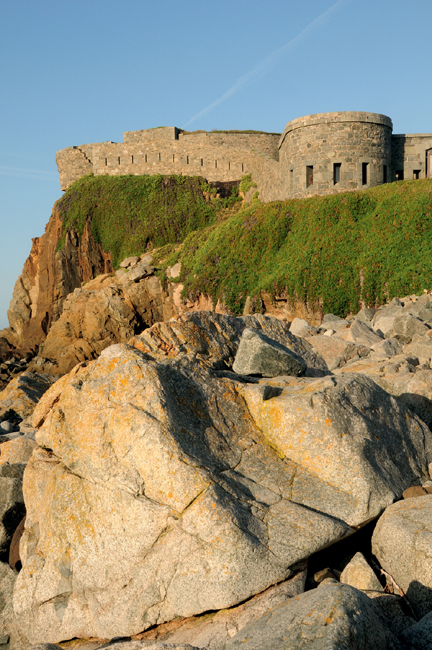
Fort Clonque stands on its own rocky island.
Mockford and Bonetti/Apa Publications
The islands lying offshore are called Les Etacs (also known as Garden Rocks). What looks like snow covering these rocky islets is, in fact, a colony of gannets, which first arrived on the rocks in 1939. The colony expanded rapidly during the war. Now about 7,000 pairs nest here from spring, departing again every autumn. Les Etacs and nearby Ortac rocks support more than 2 percent of the world’s gannet population. From the southern coast you can also see the islands of Sark, with Brecqhou to the right, then Herm and Guernsey.
From Fort Clonque you can see across to the tiny uninhabited island of Burhou 9 [map] . With no rats, no cats and very little human disturbance, the island is a haven for breeding sea birds, including more than 120 breeding pairs of puffins. In 2005 the island and surrounding wetlands were granted Ramsar status to protect the birdlife and marine species.
Burhou has a closed season from mid-March to 1 August but there are 2½-hour boat trips on certain days in summer, to view the puffin and gannet colonies on Burhou Island, Ortac and Les Etacs and the Atlantic seal colony near Burhou Reef. You might even spot the odd basking shark in summer. For information on boat trips go to www.visitalderney.com.
SOUTH COAST CLIFFS
This is Alderney at its most beautiful and ruggedly spectacular. Follow the track known as ‘The ZigZag’, as it winds uphill, and enjoy the amazing views. Turn left at the next junction, then right onto a surfaced track, which turns back into a rough track after a short distance. Continue to the viewing point at the end of the headland, above Trois Vaux Bay.
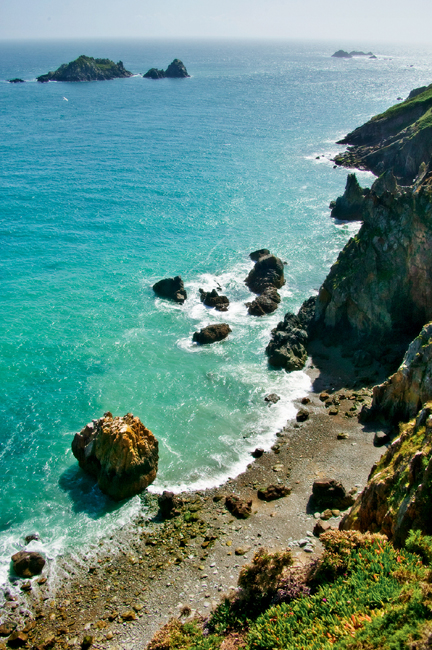
There were once steps down to Telegraph Bay, but the way is now too treacherous for it to remain open.
Visit Guernsey
TELEGRAPH BAY
Retrace your steps and take the next turn right. Ignore the next right, but take the right turn after that to head for Telegraph Bay. This was previously a favourite retreat for swimming and sunbathing if the tide was out, but since the steps fell into disrepair the beach has sadly been inaccessible. The bay is named after the Telegraph Tower that stands atop the headland, used in the early 19th century to send semaphore signals to the other islands.
Admire the views from the bench at the top of the bay, then return to the main track and turn right, skirting the southern side of the airport. The track bends northwards at the far side of the airfield, taking you, via La Petite Rue, back to St Anne’s High Street and the centre of town.
Eating Out
St Anne
Bumps Eating House
Braye Street, St Anne; tel: 01481-823 197; dinner only except on Sun and in high season, closed Wed.
The chef of this excellent eatery is also the owner, which is always good news. Vegetarian options feature on the menu alongside steaks and superb seafood. Friday night is fish night with a 3- or 4-course fixed price menu. ££
Georgian House
Victoria Street, St Anne; tel: 01481-822 471; www.georgianalderney.com; lunch and dinner.
The best place to eat at this restaurant is in the lovely sheltered garden at the rear of the hotel. The menu is a mix of traditional English pub and European cuisine, with emphasis on seafood, and use of local and sustainable produce where possible. Very friendly staff. ££
Gloria’s Food
Olliver Street, St Anne; tel: 01481-822 500; breakfast, lunch and dinner.
This is a firm favourite thanks to Gloria’s creative home-made meals, generous portions and relaxed, welcoming atmosphere. Think freshly cooked tapas, Morrocan lamb tagine and Cajun chicken. Be sure to reserve a table if going on a Friday or Saturday evening due to this place’s popularity. £–££
Jack’s Brasserie
Victoria Street, tel: 01481-823 933; daily 9am–10pm.
This is a popular spot for breakfasts, light lunches and coffee and cakes. With a sunny terrace on the High Street, it’s a good spot to relax and watch the world go by. £
Braye
Braye Beach Hotel Restaurant
Braye Street, tel: 01481-824 300, www.brayebeach.com; lunch and dinner.
Book a table overlooking the lovely Braye beach and tuck into turbot with pan-seared scallops, shellfish bisque or butter-poached lobster. The hotel is rated 4-star so prices are higher than average but the £25 set menu is good value. ££–£££
Braye Chippie
Braye Harbour, tel: 01481-823 475; Wed–Sat 5.30–9pm, longer hours in high season.
Very popular, with plenty of seating inside and out, right by the harbour. Bring your own bottle. £
First and Last
Braye Harbour, tel: 01481-823 162; closed Tue lunch.
Rita is a great hostess and produces some of the best seafood dishes in the Channel Islands. Expect freshly caught lobster, scallops and crab as well as steak, poultry and home-made desserts. Has harbour views. ££

Castle Cornet in St Peter Port.
Visit Guernsey